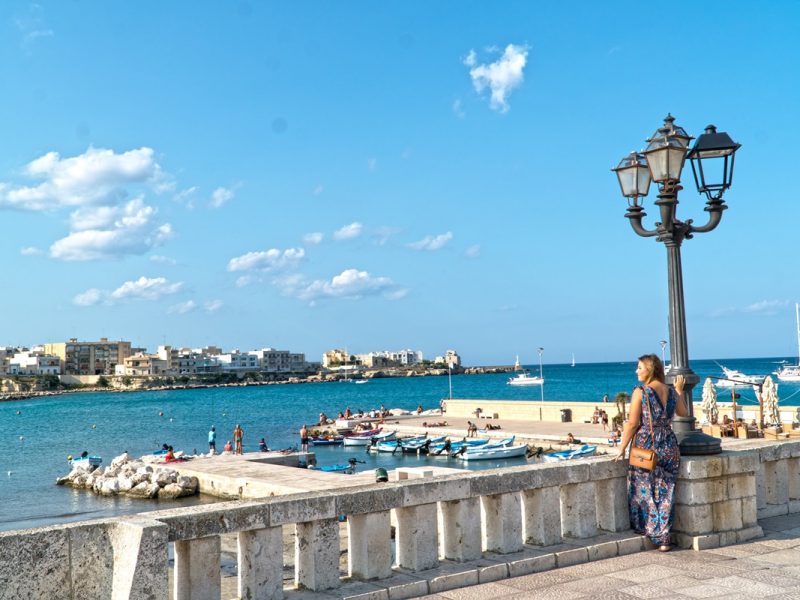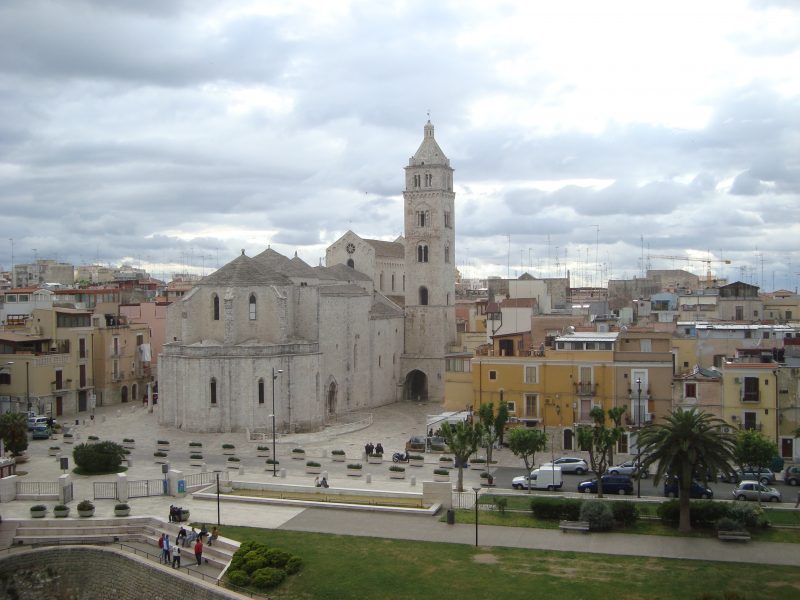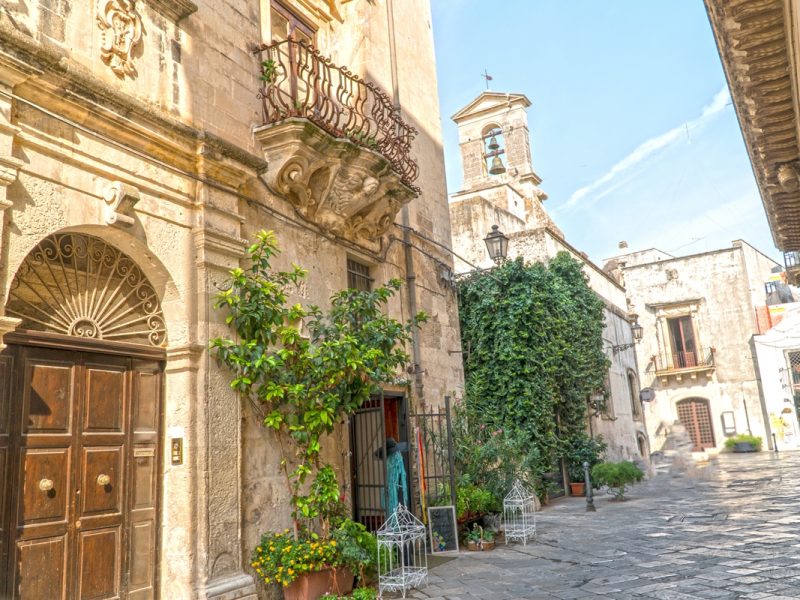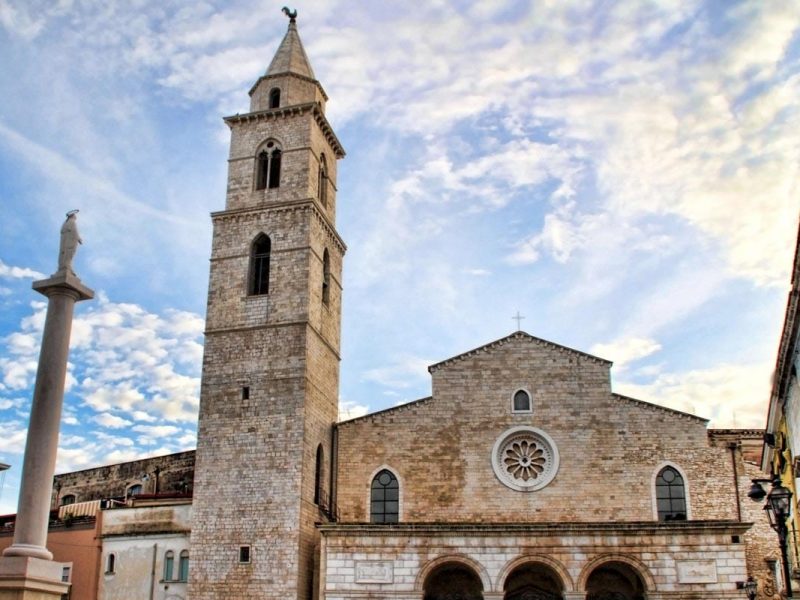The Borgo of Martina Franca
The leaves of the olive trees tremble imperceptibly with the rhythmic chant of the crickets, hidden among the ancient stone walls dividing the secular vineyards and fields. Cone-shaped stone “trulli” surround the little borgo, set placidly above them on a hill. We are in the Valle d’Itria, looking toward the ancient town of Martina Franca. White as a pearl, the little city is set between the Ionian and the Adriatic sea, in a stretch of land where cars are prohibited. Curious souls make their way on foot, through the city gate of “Porta Santo Stefano”, along the “Ringo” where the wind breathes through the sinuous forms of the balconies and their colorful flowers. Let yourself follow the curdunidde: a labyrinth of ancient stone lanes and modest houses, far from the opulence of the Ducal Palace and the Basilica of San Martino.
From the “Piazza del Plebiscito” the church of the “Collegiata” launches a languid gaze at the “Palazzo dell’ Università”, spirituality encounters what was once the political power of an era, and the “piazza” is graced with a Baroque dance that takes your breath away.
In Martina Franca, Baroque is not just a style: it has become a way of life, a way of being, that embraces culture, art and music, when the entire city becomes the stage for the Festival of the Valle d’Itria.
Elegant and refined, yet also vivacious and playful, Martina Franca wears these adjectives with pride, precious jewels to show the world. From high on her hill, with a just a touch of vanity, she whispers “ Here, magic happens every day.”
History
In the tenth century, the Muslim Saracens assailed Apulia with a ruthless trail of destruction that ravaged everything in their path, from the far north to the southernmost extremes of the region. With merciless brutality, they burnt cities to the ground, destroyed sacred monuments and slaughtered all the men, women, children, and animals they encountered. Any villages caught up in this nightmare were literally wiped off the face of the earth, their entire populations either exterminated or fleeing to safety in hidden caverns or isolated places. This was the case for a group of refugees escaping from Taranto, who sought refuge in the foothills of Monte San Martino. Soon after, a group of nomadic shepherds joined their community, and together they formed the first inhabited nucleus of Martina Franca.
The first written sources officially attesting the founding of the borgo date back to 1300, the year in which the ruler of the region, Filippo d’Angiò, offered “franchigie” (financial incentives) to anyone who would come to live there: and so was the place was called “Franca” (In Italian, an adjective used to describe an area that offers economic advantages and subsidies, in other words “gratis”, at no cost). Thus, the original name of the town, “Martina”, had the adjective “Franca” added to it. A few years later the adjective was dropped, and then added back on again in 1861.
Under the rule of the Angevin dynasty, a thick defensive wall was built around the city as protection against hostile raids from barbarians and pirates. Today, all that remains standing of this defensive structure are a few of the arched stone gates, such the gate of Santo Stefano, today, the entrance to the historical center.
In the sixteenth century, the feudal territory of Martina Franca passed into the hands of the Ducal family Caracciolo of Naples. This family represents the foundation stone for the growth of the borgo: in the latter half of the 1600’s, under the auspices of Duke Petracone V Caracciolo, an important surge in architectural development began in Martina Franca, including the edification of the “Palazzo Ducale”, the Ducal Palace. At a later date, the Basilica di San Martino was also commissioned by the Caracciolo family: the first stone for the construction of this sacred place was lain in 1747, by Duke Francesco II.
The Age of Enlightenment brought another important period of urban and economic growth to the borgo, which directly benefited from the scientific developments affecting the agricultural and livestock industries, Martina Franca’s principal commercial activities.
Regardless of the numerous benefits the noble Neapolitan family Caracciolo brought to Martina Franca, the population was not always enthusiastic about the presence of the Ducal rulers: in 1646 an ironworker named Capo di Ferro organized a protest against them, but in the end it led to nothing, and the Caracciolos continued to rule the feudal territory until 1827.
In the years of the Italian Risorgimento Movement, the borgo was animated by liberal ideals.
Palazzo Ducale di Martina Franca, the Ducal Palace
Martina Franca, like many “borghi” in Puglia, was under the domination of Raimondello Orsini del Balzo, who built one of his Medieval castles here. When the feudal territory became a Duchy, the Ducal family razed the castle to the ground and built an imposing ducal palace in its place. Work on construction began in 1668, by decree of Duke Petracone V, under the supervision of the master architect Gian Lorenzo Bernini.
The façade of the palace is designed in full Baroque glory, with tiles and a large balcony dividing it in half. By command of the Duke, four talismanic masks were sculpted under the wrought-iron balcony to keep away evil spirits: the two central figures are alchemists wearing eye-glasses, while the two side figures are represented with their tongues sticking out.
Construction of the palace was completed a century later, by Duke Francesco III Caracciolo, who entrusted the decoration of the palace to his court artist: Domenico Carella. The illustrious painter was given the task of beautifying every aspect of the noble home, in the ornate and sumptuous style of the 1700’s.
The moment you enter the palace, you have the sensation of walking directly into a masterpiece of supreme artistry. The Duke loved entering the palace through a little room decorated with objects pertaining to his daily life: cups and vases on a shelf, cameos on the wall, on a background that creates the impression of the fabric used for stage curtains. As you continue on in the perfectly conserved original structure from the 1700’s, you can admire the three main halls, where the Duke received his guests.
The first hall is dedicated to the Bible, painted with scenes depicting various sacred episodes and the symbols of the vices and virtues of mankind. Even though the scenes refer to distant epochs and faraway lands, the figures are depicted in the typical style of the period, with clothing, jewels and hairstyles in line with the fashion of the day. This was a common artistic choice in paintings of the 1700’s, to allow the guests to feel as close as possible to the images decorating the walls.
The second hall is dedicated to ancient myths, decorated with scenes from Greek and Roman mythology. Along the walls we find the adventures of Daphne and Apollo, Naxos and Arianna, to name a few. The central wall is dedicated to challenge between Atlantis and Hypomenes, while the entire ceiling celebrates the myth of Hercules freeing Hesione from the dragon.
The adventures of Hercules continue into the **ballroom, the Arcadia hall***, where the mythological hero is painted at the moment of his coronation, and slightly lower we see a little angel with a palette and paintbrushes. This small detail indicates that Hercules’ face is a self-portrait of the artist, Carella. The artist is not the only one to be featured in the paintings: in the Arcadia hall we also find the faces of Duke Francesco III Caracciolo and various members of his family. The scenes painted in this room reflect the quintessential ideal of happiness in the 1700’s, represented by a life in close contact with nature and also illuminated by the culture of the Enlightenment, resulting in an effortless state of joy that is both simple and spontaneous. Along the walls of the Arcadia hall, there are angels in the act of lighting lanterns.
The frescos in the Ducal Palace of Martina Franca are an authentic emblem of the painting style of the 1700’s, which, instead of placing the aesthetic focus on large paintings and large spaces, celebrated and glorified the small details, full of hidden meanings and curious mysteries.
Basilica di San Martino, The Basilica of St. Martin
The Basilica of San Martino was constructed over two previous religious structures built on the same site. The first structure dated back to a pre-Angevin era and was much smaller than the church existing today. The second church was constructed in Late Gothic style and was much larger, coinciding almost exactly with the same floor plan as the present day Basilica. In 1743, the city was seriously damaged by an earthquake, and the second church was destroyed. Only a few years later, on May 5, 1747, the people of Martina Franca laid the first stone for the construction of their new place of worship.
There is nothing sober about the Basilica di San Martino, displaying itself to the world in its full Rococo splendor. The façade is dominated by a statue of San Martino, St. Martin, depicted on a horse, in the act of cutting his mantle in half in order to share it with a beggar. The statue is exalted by all the decorations of the façade, which are sculpted around the figure of the patron saint.
Entering the Basilicata, you have the feeling of going into a theater, because of the sculpted balconies placed all around the perimeter. The real show, however, is the décor, which is truly spectacular, a lavish triumph immersed in a vortex of colors. The multicolored marble inlays of the walls and fixtures, the important paintings and marvelous frescos, the statues and the chapels all conduct you toward the magnificence of the central altar: a jubilation of art that surrounds the figure of San Martino, sculpted in black and golden marble, protectively flanked by two statues symbolizing Hope and Charity.
With this church, the people of Martina Franca wanted to express their profound devotion to this early Christian saint of Tours, France, to whom the city and attributed grace and miracles during the Medieval period.
Convento delle Agostiniane, The Augustinian Convent
There was once a monastery in Martina Franca dedicated to St. Francis of Assisi, which hosted the Order of Friars Minor. Today, all that remains of this ancient structure is a marble plaque in the cloister of the Convento delle Agostiniane. The destruction of the monastery was carried out by the Bishop Tommaso Caracciolo, under orders of the Pope, who decreed that it should be demolished to construct a convent for nuns in seclusion, entitled Santa Maria della Purità delle Agostiniane.
The convent is an imposing structure of large dimensions, which in order to be built, led to the destruction of most of the constructions around it, including the church of San Nicola degli Apennini. The convent accepted only young women from Martina Franca’s noble class, including some of the daughters of the Caracciolo Ducal family, thereby ensuring that a considerable fortune in property and assets came to the Order, which was then continually incremented by new donations.
The girls who chose to enter the monastic order were obliged to accept the rigorous discipline and strict rules that inspired the precepts of St. Augustine.
The entrance to the convent is a portal in Baroque style, surmounted by a statue of St. Augustine, Sant’Agostino. The interior has undergone numerous remodeling interventions, but still conserves some important historical treasures, such as a painting depicting the ‘The Last Supper’ attributed to Domenico Carella, and two sixteenth century decorative wells with sculpted columns in the inner courtyard. On the upper floor there is a balustrade with a perforated wall so the nuns could observe the external world without being seen, thus preserving the spiritual integrity of their vows.
The most characteristic part of the Convento delle Agostiniane is the Belvedere, or viewing point, built in a round, harmonious, tower-like form which recalls the style of an important architectural work by Borromini: the bell tower of Sant’Andrea delle Fratte. The Belvedere is the highest point in Martina Franca, with a wonderful view of the city and the ‘trulli’ of the Valle d’Itria.
A few decades after the convent was opened, the conservatory of Santa Maria della Misericordia was constructed, to offer a convent to the girls of Martina Franca’s lower classes.
Chiesa di San Domenico
The church of San Domenico is the most recently constructed church in Martina Franca, built in the eighteenth century. Nonetheless, the façade is a replica of the typical sixteenth century Baroque style, surmounted by a statue of San Domenico, who is surrounded by angels. The entry is embellished with a masterfully crafted sculptural frame.
The interior is a triumph of multicolored marble, magnificent altars and paintings, including the exceptional work depicting the ‘Natività del Rosario’.
Chiesa del Carmine
The Church of del Carmine is located outside the historical center, and was built in line with the principles of the Baroque style. The imposing façade is graced with niches and statues, and behind it you can see church’s octagonal-based dome, or cupola. The interior of the cupola is decorated with geometric patterns that create an optical illusion, which is not the only fascinating element of this church, in fact, the ‘Chiesa del Carmine’ is the custodian of some important masterpieces of Apulian art: a statue carved in multicolored marble by Stefano da Putignano, one of the most important sculptors in southern Italy, a magnificent crucifix, and a painting depicting the Madonna del Carmine surrounded by saints.
Il Bosco delle Pianelle, The Pianelle Woods
Halfway between Martina Franca and Massafra there is a place that seems to have come straight out of a fairy tale. It is a forest, where children can imagine Hansel and Gretel leaving their trail of crumbs, and Snow White’s seven dwarves bouncing joyfully home after a day’s work.
The Bosco delle Pianelle is actually not just a simple forest: it is a biotope. A biotope is a protected natural reserve where rare species of flora and fauna live: rare butterflies, mammals and reptiles have found refuge here among the Mediterranean vegetation, Hornbeam trees and the Carpino Nero, and Reverella (two species of Oak) trees.
The Bosco delle Pianelle is a part of the history of Martina Franca, because numerous archeological relics have been found nearby, evidence of Pre-historic settlements in the area. Moreover, millenniums later, the “briganti” found refuge here among these woods, which were a perfect place for them to take cover between one rebellion and another.
Today, the Bosco delle Pianelle has become a shining light in the sector of cross-cultural education. Management of the reserve has been entrusted to a group of local associations, who organize theatrical events, exhibitions, laboratories and workshops, and also offer fully equipped picnic areas. If you long to experience solitude in glorious contact with nature in an uncontaminated natural oasis, the paths of these woods are the ideal place to go hiking or mountain bike riding.
In the Bosco delle Pianelle, you can leave your worries behind and re-connect with the beauty of the world.
Il Festival della Valle d’Idria, The Festival of the Valle d’Itria
Have you ever enjoyed a ‘concert al sorbet’? You might be in a Baroque hall, on a summer afternoon, as the heat of the day offers a cooling truce, and the sun descends over the olive trees and monuments. ‘Concerts al sorbet’ are not chic items on the menu of a gourmet chef, but small, intimate concerts that you can enjoy in the cloister of the Chiesa di San Domenico, and are just one example of the many events listed on the extensive program of the Festival of the Valle d’Itria.
For music lovers, the Palazzo Ducale is the central hub of the festival, but the music is everywhere: the nave of the Collegiata di San Martino, the cloisters, the piazzas, the winding lanes of the borgo, all open their arms to embrace and welcome you to the festivities.
Martina Franca also displays her elegance when it comes to music, especially when it comes to music. The splendid notes of sixteenth century compositions blend with nineteenth century tones, opera arias accompany you along the ancient streets, original songs befriend familiar works, forgotten songs are rediscovered, and new voices follow grand maestros in an exquisite labyrinth of music and melodies that winds through the borgo at all hours, captivating and enchanting one and all.
Every year, the Festival of Valle d’Idria attracts numerous visitors to this city in the Taranto region. Music lovers of all kinds come to immerse themselves in a unique environment that evokes the opulent receptions given by the Ducal family Caracciolo.
Since 1975, Martina Franca, the Palazzo Ducale, and the entire borgo have offered this homage to classical music, transforming the entire town into an open stage, making it available to anyone and everyone, thanks to the Foundation “Paolo Grassi”, the organizer of the Festival of the Valle d’Itria, which also offers seminars and laboratories to introduce people to opera, bringing this marvelous art to listeners of all ages and backgrounds.
Donato Carrisi
In 2016, when the Spanish bookstores displayed Donato Carrisi’s new novel, they presented him as the best-selling Italian author of thrillers in the world. In Italy, this has been common knowledge for quite some time, in fact his books have sold more than three million copies, officially consecrating him as the Maestro of Italian thrillers.
Donato Carrisi was born in 1973, in Martina Franca. As a young man he moved to Rome, where he began a highly productive collaboration with one of Italy’s most prestigious newspapers, Corriere della Sera, and also recieved his Law degree, continuing on to specialize in Criminology and Behavioral Science.
Before becoming a novelist, Donato Carrisi worked as a playwright, and then as a screenwriter for television series.
In 2009, he published his first novel, “Il Suggeritore” (in English available as “The Whisperer”, editions published in 2011, 2013), for which he won the prestigious ‘Premio Bancarella’ award. From there his career took off, and he began churning out one success after another: “The Lost Girls of Rome”, “The Hunter of the Dark”, “The Vanished Ones” are some of the titles available in English.
In 2016, he published “La Ragazza della Nebbia” (in English published as “The Girl in the Fog” 2017, featured as a Sunday Times Crime Book of the Month), and in 2017 wrote the screenplay to transform the novel into a film, which was released in December 2017.
On December 4th 2017, his latest work, “L’uomo del labirinto” arrived in the Italian bookstores, published by Longanesi Press (which unofficially translates as: ‘The Man of the Labyrinth’), with the official title in English pending.
Rosaria Console
Rosaria (Rosalba) Console is an Italian marathon runner, born in Martina Franca in 1979.
She began her athletic career at the age of 11, when she began practicing gymnastics. In 2001, she ran her first marathon, in Padua, and her career took off from there, regardless of the various difficulties caused by some physical problems.
Rosaria Console has beaten six personal records, won the 2004 Vienna Marathon, has been awarded six Italian medals, and a gold medal at the “Universiadi”.
The “Capocollo” cured salami of Martina Franca
For some years now, the name Martina Franca has become inextricably linked with its premium salami: the “Capocollo”, an artisan salami produced exclusively in this borgo of Puglia, protected and rigorously monitored by an exclusive slow food consortium and exported world-wide.
The production of Capocollo of Martina Franca is a long and detailed process, carried out in three phases. First, “la concia”, or flavoring: the particular cut of meat, taken from the neck muscle between the head and the shoulder (“capo”-head, “collo”-neck) is marinated in vincotto and wild herbs from the Alta Murgia. Second, “L’asciugatura”, or cool-drying process: the meat is placed in a sack of skin and hung to dry slowly in well-ventilated stone rooms. Third, “l’essiccatura”, or heat-drying process: the dried sacks are placed in an wood-burning oven and smoked with oak wood.
The result is a cured-meat salami with a balanced and harmonious flavor that is loved by everyone, satisfying even the most discerning palette.
The Capocollo of Martina Franca is supervised and accredited by the prestigious Presidio Slow Food commission.

 Italiano
Italiano
 Deutsch
Deutsch










